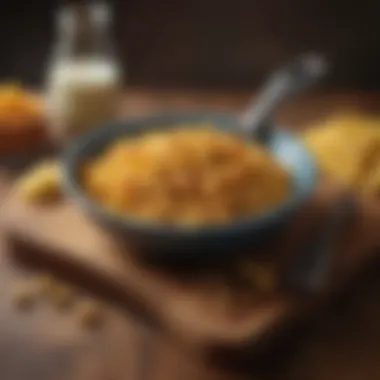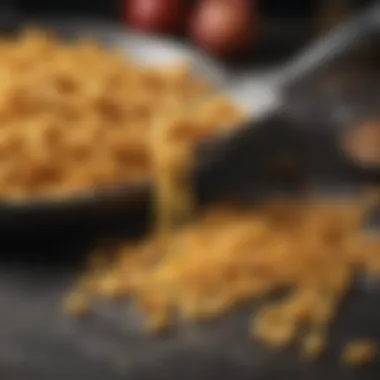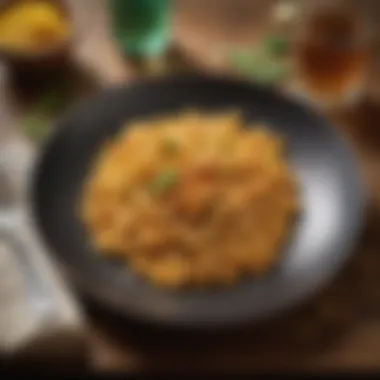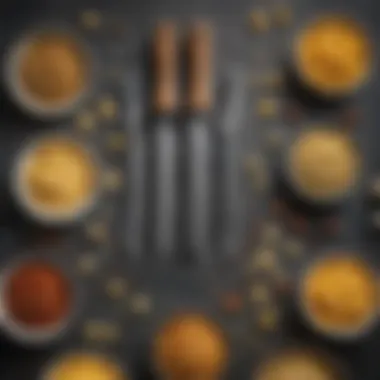The Spaetzle Tool: Mastering Traditional German Noodles


Intro
The spaetzle tool occupies a distinct niche in the world of culinary utensils. This specialized implement not only facilitates the creation of spaetzle but also adds an authentic touch to other traditional dishes. Spaetzle, with its origins rooted in Germany, embodies comfort food that enhances a variety of meals. Understanding the complexity and function of this tool is essential for anyone interested in expanding their cooking repertoire.
In this article, we will delve into the inception and evolution of the spaetzle tool. We will discuss its design, functionality, and various practical uses. Additionally, we will provide guidance on how to select the right tool, maintain it properly, and explore delectable recipes showcasing spaetzle in all its forms.
Prologue to the Spaetzle Tool
Understanding the spaetzle tool is essential for anyone enthusiastic about culinary arts, particularly those interested in German cuisine. This tool plays a crucial role in crafting spaetzle, which are small, soft noodles often enjoyed in various dishes. The significance of this utensil comes from the unique texture and taste it helps create in spaetzle, allowing home cooks and chefs alike to prepare authentic meals.
The exploration of the spaetzle tool involves examining its definition and the context in which it has evolved over time. Knowledge of its history enhances one's appreciation and ability to use the tool effectively.
Definition of the Spaetzle Tool
The spaetzle tool is a specialized kitchen implement designed primarily for the preparation of spaetzle, a traditional German noodle. Typically, it can be categorized into different designs, including a spaetzle maker or a colander. Each type serves the fundamental purpose of pushing dough through holes, resulting in small, irregularly shaped pieces that cook quickly in boiling water. The tool's functionality makes it indispensable for both casual cooking and gourmet preparations.
Historical Context
Historically, spaetzle has roots in regions that are now parts of Germany, Austria, and Switzerland. The term "spaetzle" itself means "little sparrows" in German, which reflects the shape of these noodles. The origins of the spaetzle tool trace back to traditional methods of noodle-making. Initially, cooks used wooden boards or even their hands to push the dough into boiling water.
The tool has evolved significantly over time. In the 19th century, dedicated utensil designs started appearing, which allowed for more uniform shapes and sizes. This advancement enhanced cooking efficiency, making it easier to prepare large batches. The spaetzle tool is not merely a functional item; it embodies a rich cultural heritage, linking modern culinary practices to age-old traditions and recipes.
In summary, this section lays the groundwork for understanding the importance of the spaetzle tool and its historical significance in kitchen practices. By recognizing how it has functioned through time, cooks can appreciate its role in both everyday recipes and gourmet cuisine.
Understanding Spaetzle
Understanding spaetzle is crucial to appreciating the versatility of the spaetzle tool. This section will cover the essence of this beloved dish and its rich background, providing insight into why home cooks should become familiar with it. Spaetzle serves as not merely a meal component but rather a canvas for creativity, allowing for diverse flavor enhancements that can suit any palate.
What is Spaetzle?
Spaetzle are small, soft noodles originated from traditionally German cuisine. They are made from a simple batter consisting mainly of flour, eggs, and water. This simplicity in ingredients belies the complexity of textures and flavors they can yield. The batter is either pressed through a specific spaetzle tool into boiling water or scraped from a wooden board. Once cooked, the spaetzle usually have a soft texture, ideally pairing well with rich sauces or gravies.
In essence, they resemble dumplings more than typical noodles, providing comfort with every bite. Their shape is irregular, which allows them to hold onto sauces effectively, enhancing the dish as a whole. Spaetzle can be served in various ways: from being sautéed in butter with herbs to being included in soups or served alongside meats.
Cultural Significance of Spaetzle
Spaetzle is more than just food; it plays a meaningful role in various cultures, particularly in Germany, Austria, and Switzerland. In these regions, spaetzle is often present in family gatherings, celebrations, and Sunday dinners—near and dear to many.
"Spaetzle is a nod to tradition, bringing families together over comforting flavors."
While being a staple in gourmet establishments, it is equally significant in home kitchens. During festive occasions, spaetzle can bring a sense of nostalgia, reminding individuals of recipes passed down through generations. Moreover, spaetzle reflects regional cooking variations, evolving from a simple peasant fare into a dish that graces fine dining menus. Additionally, cultural adaptations have emerged, allowing spaetzle to fit into various culinary uses worldwide, which underscores its global appeal.
In summary, understanding spaetzle enriches appreciation for the spaetzle tool, as it reveals its indispensable role in crafting a dish that combines simplicity with tradition.
Design and Features of the Spaetzle Tool
The design and features of the spaetzle tool play a crucial role in its effectiveness and usability. Understanding these elements enhances the experience of making spaetzle and allows cooks to select the right tool for their needs. A well-designed spaetzle tool can significantly improve the texture and uniformity of the noodles, which is vital to achieving a traditional dish.
Common Materials Used
When it comes to the materials used in spaetzle tools, several options are commonly found. The most typical materials include:


- Stainless Steel: Known for its durability and resistance to rust, stainless steel is a favorite for many cooks. It is easy to clean and can withstand high temperatures.
- Plastic: Lighter and often more affordable, plastic spaetzle tools can be susceptible to warping. However, they often have non-stick surfaces, which simplify the cooking process.
- Wood: Traditional wooden tools provide an aesthetic and tactile experience. They also do not react with any ingredients, which is important for preserving flavors.
- Silicone: Some modern designs incorporate silicone, known for its flexibility and non-stick properties. However, it can be less durable over time compared to metal tools.
Each material has its own advantages and disadvantages. Choosing the right one often comes down to personal preference and specific cooking practices.
Innovative Designs
The evolution of spaetzle tools has led to numerous innovative designs that enhance functionality and ease of use. Some of these feature:
- Perforated Plates: These specialized plates allow for controlled shaping of the spaetzle. The holes vary in size, leading to different noodle dimensions.
- Ramps and Graters: Some tools integrate a ramp-like design, which helps the dough slide easily into boiling water. Grater-style tools allow for even faster prep.
- Adjustable Height: Many modern spaetzle tools offer height adjustments to accommodate various pot sizes. This versatility can be exceedingly helpful when making larger batches.
- Ergonomic Handles: Comfort is paramount, especially during long cooking sessions. Ergonomic designs reduce hand fatigue, making it easier to produce spaetzle efficiently.
These innovative designs recognize the diverse needs of cooks, enhancing the overall experience of making spaetzle.
Choosing the Right Spaetzle Tool
Selecting the appropriate spaetzle tool involves several factors. Here are some considerations to keep in mind:
- Cooking Frequency: For avid cooks, investing in a stainless steel or premium tool can provide long-term benefits. Casual cooks may opt for a less expensive plastic tool.
- Space and Storage: If kitchen space is limited, a compact design with multi-functionality is essential. Some tools can be folded or stored easily.
- Ease of Cleaning: Opt for tools that are dishwasher safe or easy to clean by hand. Messy tools can lead to an unpleasant cooking experience.
- User Experience: Finally, personal comfort and intuition during use are critical. Try different options when possible to find what feels best.
Functionality of the Spaetzle Tool
Understanding the functionality of the spaetzle tool is crucial for both novice cooks and seasoned chefs. This kitchen implement is not merely a gadget; it plays an essential role in producing spaetzle, which are delicate and light noodles. Proper use of the tool significantly impacts the texture and consistency of the final product, making the understanding of its functionality vital. The spaetzle tool simplifies and enhances the process of creating this traditional dish, offering benefits such as ease of use, consistent results, and speed in preparation.
How the Tool Works
The operation of the spaetzle tool is straightforward but effective. The tool typically consists of a sieve or a perforated plate through which the dough is pressed into boiling water. Here’s how it generally works:
- Dough Preparation: Once you have your spaetzle dough ready, it must be thin enough to flow but thick enough to hold shape.
- Boiling Water: A large pot is filled with water, ideally seasoned with salt to flavor the noodles during cooking.
- Using the Tool: The dough is either placed in the sieve or on the perforated plate. The remaining part involves either pushing or scraping the dough through the holes. The result is small, drop-like pieces of dough that cook almost instantly when they hit the water.
- Cooking: After a few minutes, when the spaetzle rise to the surface, they are done and can be removed using a slotted spoon.
This process is efficient and allows for an even cooking of the noodles, ensuring they do not stick together, leading to a better final dish. The simple mechanics of this tool make it accessible for most cooking skill levels, while still providing professional results.
Preparing the Spaetzle Dough
The success of using the spaetzle tool largely hinges on how the dough is prepared. Making the dough is a simple process but requires attention to proportions and ingredients. Here are the key steps:
- Ingredients: Common components include flour, eggs, water, and salt. Typically, the recipe calls for roughly equal parts of flour and eggs. Adjustments can be made according to the desired texture.
- Mixing the Dough: Combine the ingredients in a bowl. The goal is to achieve a batter-like consistency that is thick but also fluid enough to pass through the holes of the tool. This might require some experimentation.
- Resting the Dough: Allowing the mixture to rest for about 30 minutes can improve the texture. This gives the gluten time to relax, resulting in chewier spaetzle.
- Test Batch: Before committing the entire batch, consider testing a small amount of dough. This initial sample can help determine if adjustments are needed in terms of consistency or flavor.
By following these steps, cooks can ensure they create the optimal dough for use with the spaetzle tool, resulting in delicate noodles that are satisfying to eat and pleasing in appearance.
The spaetzle tool is not just for novices; skilled chefs appreciate its role in preserving tradition while offering modern culinary convenience.
Practical Uses of the Spaetzle Tool
The spaetzle tool is more than just a specialized kitchen device; it serves a range of purposes that can elevate the cooking experience. Understanding its practical uses can inspire both seasoned chefs and newcomers to explore the versatility of spaetzle in diverse culinary applications.
In Everyday Cooking
In daily cooking, the spaetzle tool simplifies the process of making this beloved dish. Spaetzle is quick to prepare, requiring minimal ingredients such as flour, eggs, and salt. The tool allows for effortless shaping and cutting of the dough into bite-sized pieces that cook swiftly in boiling water. This efficiency makes spaetzle an excellent choice for weeknight meals or last-minute gatherings.
When using the spaetzle tool, one can create numerous variations to suit various tastes. For instance, by incorporating spinach or beet puree into the dough, different colors and flavors arise. This flexibility in preparation motivates home cooks to experiment while enhancing their meal presentations.
Moreover, the texture of spaetzle produced by a proper tool is superior. The tool helps form small dumplings that are light and airy, as opposed to heavy and clumpy alternatives. The ease of use contributes to its popularity, allowing even those who are inexperienced in the kitchen to achieve satisfying results.
In Gourmet Dishes


The spaetzle tool is not limited to everyday meals; it can also play a vital role in creating gourmet dishes. For chefs aiming to impress guests, spaetzle can serve as a delightful base, pairing well with a variety of sauces and proteins. For example, it provides an excellent accompaniment to rich gravies or creamy mushroom sauces. As a versatile side dish, spaetzle complements meats, including roasted chicken or braised beef, enhancing the overall dining experience.
In fine dining contexts, spaetzle can be elevated by imaginative presentation and unique flavor pairings. Topped with fresh herbs, sautéed vegetables, or served in a puddle of exquisite broth, spaetzle can transition seamlessly from rustic comfort food to an elegant dish fit for any upscale menu. Offering a creative twist, infusing the dough with herbs or cheese opens doors to new culinary horizons.
"The spaetzle tool is essential not just for home cooks but also for chefs who respect tradition while pursuing innovation in their dishes."
Overall, the spaetzle tool proves to be an invaluable asset in any kitchen, whether for quick everyday meals or high-end culinary creations. It fosters creativity and simplicity, allowing cooks to explore diverse flavors while enjoying the process of making this traditional German dish.
Maintenance and Care for Spaetzle Tools
Maintaining and caring for spaetzle tools is crucial for their longevity and effectiveness in the kitchen. Proper maintenance not only ensures that the tools function as intended but also preserves the quality of the food prepared with them. Neglect can lead to food residue buildup or even damage to the tool itself, impacting both its performance and the taste of the spaetzle you create. Understanding how to clean and store your spaetzle tool extends its lifespan, making it a wise investment for any culinary enthusiast.
Cleaning Tips
Cleaning spaetzle tools is straightforward yet essential. Often made of materials like stainless steel or plastic, these tools can accumulate dough, flour, and other residues with use. To ensure cleanliness:
- Immediate Rinse: After using the spaetzle tool, rinse it with warm water. This prevents dough from sticking and drying onto the surface.
- Gentle Scrubbing: Use a soft sponge or cloth to clean the tool. Avoid abrasive scrubbers that can scratch the surface, especially for aluminum or non-stick coatings.
- Soak When Necessary: For stubborn residues, soaking the tool in warm, soapy water can help. After a few minutes, scrub gently to remove the remaining bits.
- Dishwasher Safety: If the tool is dishwasher safe, place it on the top rack to minimize exposure to intense heat.
- Thorough Drying: Always dry the tool completely before storing. This prevents moisture from causing rust or deterioration, especially for metal tools.
Storage Recommendations
Storing spaetzle tools properly can protect them from damage and ensure they are ready for use whenever needed.
- Dry Storage: Ensure the storage area is dry to prevent moisture buildup that can damage the tools.
- Avoid Heavy Weight: Do not stack heavy objects on top of the spaetzle tool to prevent warping. It's best to keep them in a dedicated space.
- Use a Dedicated Container: Consider using a container or a drawer for tools. This keeps them organized and easy to access.
- Hang If Possible: If you have limited drawer space, hanging the tool can be a good approach. This also avoids scratches from sliding against other utensils.
- Check Periodically: Regularly inspect the spaetzle tool for any signs of wear or damage. Early detection can save you from bigger issues later on.
Proper care and maintenance of your spaetzle tools will enhance their performance and ensure delicious results every time.
Recipes Using Spaetzle
The section on recipes using spaetzle holds a significant place in this article. It showcases the versatility of spaetzle as a beloved staple in various cuisines. Understanding recipes allows cooks to appreciate the culinary versatility of this tool and its ingredient. Through these recipes, one can see how spaetzle can serve as a base for both traditional and modern dishes. The focus on recipes emphasizes a hands-on approach, inviting readers to engage with this delightful food.
Traditional German Recipes
Traditional German recipes highlight the cultural roots of spaetzle and its importance in German cuisine. One classic dish is Käsespätzle. It combines spaetzle with cheese, often Emmental, and is topped with caramelized onions. This dish exemplifies how spaetzle can absorb flavors, making it a perfect vehicle for rich and comforting tastes.
Another popular dish is Spaetzle with Mushroom Sauce. This dish includes mushrooms sautéed with onions and garlic, creating a rich sauce that complements the spaetzle beautifully. The choice of mushrooms, such as chanterelles or cremini, can enhance the overall flavor, making it a favorite among mushroom lovers.
Some additional traditional recipes include:
- Schwäbische Spätzle: Served as a side dish with meats or stews.
- Spätzle with Goulash: A hearty meal, great for colder weather.
These recipes not only reflect regional flavors but also the culinary traditions passed down through generations.
Modern Variations
Modern variations of spaetzle recipes offer a fresh twist on classic dishes. Food lovers are increasingly experimenting, bringing in new flavors and techniques. For example, gluten-free spaetzle made with either rice flour or chickpea flour caters to dietary needs while retaining the essence of the noodle.
Another contemporary take involves using spaetzle in stir-fried dishes. Cooks sauté spaetzle with various vegetables and proteins, combining many cuisines into one dish. The noodles soak up the flavors of sauces like soy or teriyaki, providing a delightful fusion experience.
Innovative modern recipes can include:
- Buffalo Chicken Spaetzle: Tossed in buffalo sauce for a spicy kick.
- Mediterranean Spaetzle Salad: With olives, feta, and a lemon dressing for a refreshing dish.
These modern recipes reflect a trend where chefs and home cooks reinterpret traditional dishes, making spaetzle relevant and exciting in today’s culinary landscape. The potential for innovation showcases the spaetzle tool's ability to adapt, making it a valuable asset in any kitchen.


Nutritional Aspects of Spaetzle
Understanding the nutritional aspects of spaetzle is crucial for those who appreciate both the culinary and health benefits of this beloved dish. Spaetzle is primarily made from basic ingredients such as flour, eggs, and water, leading to a simple yet versatile noodle option. This section analyzes the key components of spaetzle and how it fits into various dietary practices.
Ingredients Breakdown
The main ingredients in spaetzle each carry significant nutritional value:
- Flour: Usually made with all-purpose wheat flour, which provides carbohydrates, essential for energy. Whole wheat flour options offer additional fiber.
- Eggs: They add protein, which is vital for muscle repair and overall health. The yolk also contains vitamins A, D, E, and B12, contributing to nutritional benefits.
- Water: While it does not add calories or nutrition, water is essential for hydration and the dough's texture.
- Salt: A pinch is typically added for flavor, but too much sodium is something to watch in diets.
Spaetzle can be adjusted with a variety of flours, such as spelt or gluten-free alternatives, broadening its nutritional profile.
By knowing the ingredients, one can better understand the nutritional makeup of spaetzle and how to alter it for specific dietary needs.
Dietary Considerations
Spaetzle, although nutritious, may not be suitable for everyone. Here are some considerations:
- Gluten Sensitivity: Traditional spaetzle contains wheat flour, which is not suitable for those with celiac disease or gluten intolerance. Options made with gluten-free flour blends can accommodate these dietary restrictions.
- Caloric Intake: Depending on preparation and serving size, spaetzle can be high in calories due to the carbohydrate content. This should be accounted for in meal planning, especially for those watching their weight.
- Balanced Diet: When paired with vegetables, proteins, and healthy fats, spaetzle can fit into a balanced meal. Adding nutrient-dense ingredients can elevate the nutritional quality of the dish.
Understanding these aspects helps in deciding how spaetzle can fit into an individual's diet while enjoying its unique taste. Educating oneself about ingredients and potential dietary impacts will lead to more informed culinary choices.
Exploring Global Variants of Spaetzle
The spaetzle tool serves as a bridge not only to German cuisine but also to a broader culinary narrative that spans various cultures. As spaetzle has gained popularity beyond its origins, many countries have adopted and adapted the concept, resulting in fascinating global variants. Recognizing these differences is crucial for food lovers interested in exploring the versatility of this simple yet profound dish.
Regional Differences
In Germany, spaetzle is often celebrated as a comfort food, with each region showcasing its own unique twist. For instance, the Swabians have a specific recipe known for its delicate texture, achieved by using a mix of flour, eggs, and water. In contrast, in Austria, spaetzle may be enriched with cheese, creating a dish known as "Käsespätzle," which is both hearty and satisfying.
Outside of Germany, the variations continue. In Hungary, for example, they have a similar dish called "Nokedli," which also incorporates flour and eggs but may often include potatoes for added flavor. This slight change not only alters the texture but also enhances the taste profile, making it a delightful addition to any meal.
Each regional variant arises from local ingredients, traditions, and culinary customs. Recognizing these differences provides insights into not just the preparation but the cultural significance behind each dish. Food history enthusiasts might find it interesting that the same basic ingredients can yield a variety of textures and flavors depending on the method of preparation and cooking.
Fusion Cuisine Ideas
As our global culinary landscape evolves, spaetzle finds itself in intriguing fusion cuisine concepts. This place of intersection offers limitless potential for innovation. For example, combining traditional spaetzle with Asian flavors produces dishes that merge the best of both worlds.
A creative take involves integrating spaetzle into stir-fries, where the noodles absorb rich sauces typically associated with Asian cooking. The delicate texture of spaetzle complements stir-fried vegetables and proteins very well, creating an exciting dish that appeals to diverse palates.
Another innovative concept is using spaetzle as a base for various sauces, much like one would utilize pasta. Enriching it with creamy sauces, such as a garlic-cilantro blend or a spicy Szechuan sauce, demonstrates the versatility of the spaetzle tool and highlights its adaptability to different ingredients and cuisines.
Epilogue
The conclusion holds a critical place within this article, serving as a summation that consolidates the ideas discussed throughout. Understanding the importance of the spaetzle tool is key for anyone who wishes to delve into authentic culinary experiences.
This tool not only facilitates the crafting of spaetzle but also connects users to a rich cultural heritage. It embodies the art of traditional cooking, making it essential for home cooks who want to recreate genuine recipes or explore new culinary ventures. By using the right spaetzle tool, cooks can achieve consistent results, leading to a delicious end product that often enhances the overall dining experience.
Summary of Key Points
To encapsulate what has been discussed:
- The spaetzle tool is integral for making spaetzle, a traditional German noodle.
- Historical context enriches the appreciation of this culinary implement.
- Choosing the optimal tool involves consideration of design, material, and personal needs.
- Maintaining the tool is necessary for longevity and performance.
- Recipes and ways to integrate spaetzle into both traditional and modern dishes are plentiful.
The Future of Spaetzle Tools
As culinary trends evolve, the spaetzle tool continues to pivot in modern kitchens. Advancement in kitchen technology and increased appreciation for artisanal goods may shape its future.
Innovative designs are emerging, such as those that combine functionality with aesthetic appeal. This trend indicates a possible fusion of traditional cooking tools with modern needs. Consequently, aspiring cooks can expect more versatile and user-friendly options coming to market.







